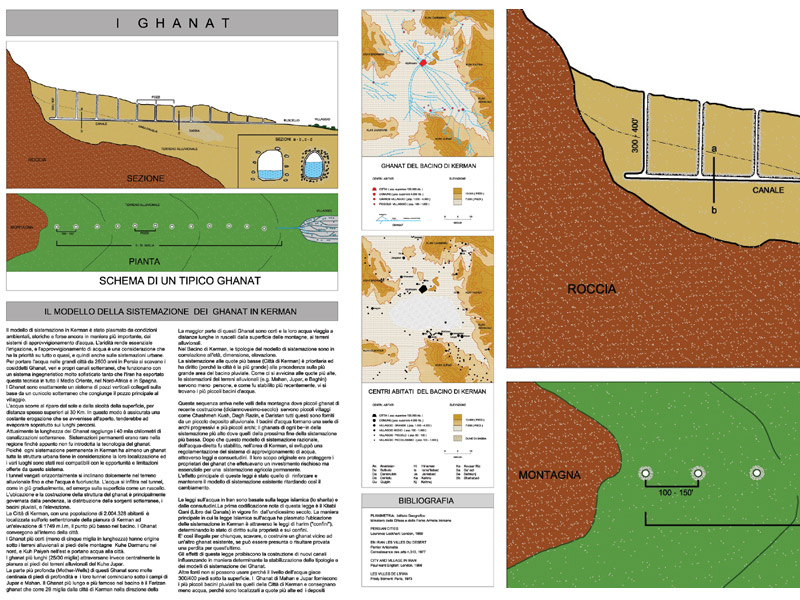Ghanat (Qanat)
The Iranian Qanat system
Year
VII secolo d.C.
The pattern of accommodation in many southern Iranian cities has been shaped by environmental conditions, historical and perhaps most importantly, water supply systems. Aridity makes irrigation essential, and water supply is a consideration that has priority over almost everything, and therefore also over urban settlements. To bring water to the big cities for 2500 years in Persia, the so-called Ghanat are excavated, real underground channels, which work with a very sophisticated engineering system, so much so that Iran has exported this technique throughout the Middle East, in the North. -Africa and Spain.
The Ghanat are exactly a system of vertical wells connected at the base by an underground tunnel that connects the main well to the village.
The water flows away from the sun and the drought of the surface, for distances often greater than 30 km. In this way a constant supply is ensured which, if it happened outdoors, would tend to evaporate especially on long journeys.
Currently the length of the Ghanat reaches 40 thousand kilometers of underground channels. Permanent settlements were rare in the region until the ghanat technology was introduced. Since every permanent settlement in Kerman has at least one ghanat, the whole urban structure takes into consideration their location and the various places have been made compatible with the opportunities and limitations offered by this system.
The horizontally dug tunnels slope gently into the alluvial soil until the water has escaped. The water infiltrates the tunnel, runs down gradually, and emerges on the surface like a stream.
The location and construction of the ghanat structure is mainly governed by the slope, the distribution of the underground springs, the rain basins, and the elevation.
The exact number of ghanats currently bringing water to the city is uncertain. The high density of ghanat tunnels in the rain basin of the city of Kerman has practically created a legal barrier to the construction of new ones. At the northern edge of the Mahan farmland under which the ghanat tunnels to the City of Kerman are located more than five hundred wells in an area of less than two square miles. Since the law prohibits the construction of new ghanats or wells at a distance of less than one kilometer from existing wells, much of the Kerman Plain has been closed to new construction. For this reason there are no other large accommodations on the Kerman plain. All other large settlements in the Kerman Basin are located on the high alluvial soils, beyond the rain basin drained by the urban kerman ghanat. The largest of these are Mahan (over 6,000 people) and Jupar (over 4,000 people); Both are located at an altitude of 700/800 feet higher than the City of Kerman.
The Ghanats are the only source of water in these cities. Most of these Ghanats are short, and their water travels long distances in streams from the surface of the mountains to alluvial soils. In the Kerman Basin, the typologies of the accommodation model are correlated to age, size, elevation. Accommodation at the lowest altitudes (City of Kerman) has priority and is entitled (because the city is the largest) to the right of way over the largest area of the rain basin. As one approaches higher elevations, alluvial land settlements (e.g. Mahan, Jupar, and Baghin) serve fewer people, and as was more recently established, smaller bodies of water are found there. This sequence arrives in the mountain valleys where small newly built (nineteenth-century) ghanats serve small villages such as Chashmeh Kush, Dagh Razin, and Daristan all of these are supplied by a small alluvial deposit.
The water basins form a series of progressive arches and smaller arches; the ghanats of each be ~ in of the higher settlement where those of the next end of the lower settlement. After this rational, water-directed arrangement model was established, a regulation of the water supply system developed through laws and customs in the Kerman area. Their original purpose was to protect ghanat owners who made a risky but essential investment in permanent agricultural settlements. The main effect of these laws has been to reinforce and maintain the existing accommodation model thus delaying change.
Water laws in Iran are based on Islamic law (the sharita) and customs. The earliest known codification of this law is the Kitabi Qani (Book of Qanats) in force since the 11th century. The main way in which Islamic water law has shaped the location of accommodation in Kerman is through harim ("boundary") laws, determining the rule of law on property and borders. It is thus illegal for anyone to dig, or build a ghanat close to another existing ghanat, if a loss for the latter can be presumed or proven. The effects of this law prohibit the construction of new channels, influencing in a decisive way the stabilization of the types and models of accommodation of the Ghanats. Other sources cannot be used because the water level lies 300/400 feet below the surface. The Ghanats of Mahan and Jupar provide the smallest rain basins among those of the City of Kerman and deliver less water, because they are located at higher altitudes and the alluvial deposits are fewer.
Drawings that can be purchased

20 €
How the download works?
To download files from Archweb.com there are 4 types of downloads, identified by 4 different colors. Discover the subscriptions
Free
for all
Free
for Archweb users
Subscription
for Premium users
Single purchase
pay 1 and download 1

































































